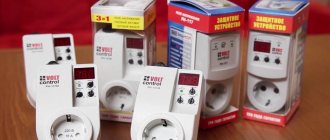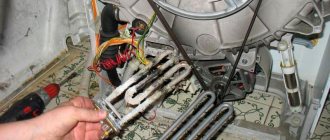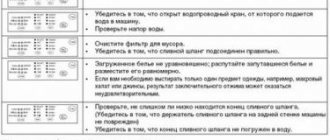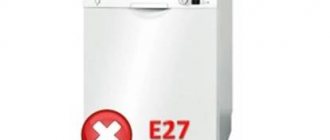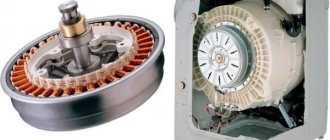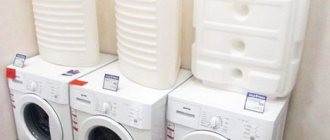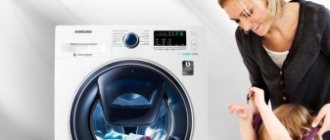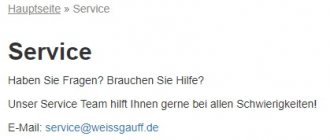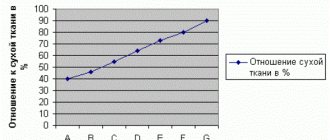Washing machine display
If a problem is detected, the washing machine stops working and immediately displays an error message. Signaling methods depend on the specific model, rather, on its age. Most new models are equipped with a display with a segment indicator on which one or another code is displayed.
Most old cars also have a built-in diagnostic system, only the results of its operation are communicated to the user in a different way, by turning on the lamps on the display panel. If you look at the documentation for the machine, you can easily find a table there that allows you to clearly determine the type of error and identify the faulty unit.
Washing machines without a display use a lack of water supply indicator and a number of operating mode indicators to display the error code:
- prewash;
- wash;
- rinsing;
- stop;
- spin
In addition to them, indicators are used to indicate an open hatch and a dirty drain filter. Combinations of these lamps with the “Service” lamp make it possible to clearly identify a breakdown.
It doesn’t matter how exactly the device signals an error, as soon as this occurs, you need to immediately take measures to correct the situation. It is important to understand that ignoring even a seemingly insignificant error may lead to the need to replace a number of expensive device components in the near future.
Whirlpool washing machine error codes
If an iron breaks down at home, it is unlikely that it will be able to tell its owner about the nature of the breakdown. Washing machines are another matter - they are equipped with self-diagnosis systems that indicate all malfunctions.
Looking at the error codes of Whirlpool washing machines, presented in table form, we will be able to quickly bring the machine back to life - many breakdowns can be easily fixed at home.
Similarly, you can find out the error codes of Kandy washing machines on our website.
Fault codes for Whirlpool washing machines are displayed on the control modules - on a display where we see the time until the end of the wash. To clarify the malfunction, you need to read the code and check the table.
| Code | Description of the problem | Possible causes |
| F01or FH | Failure in the water fill system (low level or no fill) |
|
| F02 or FA | AquaStop triggered |
|
| F03 or FP | No water drain |
|
| F04 | Slow water heating or no heating at all |
|
| F05 | Temperature sensor does not work | The sensor and its electrical circuits are checked. |
| F06 | There is no signal from the tachogenerator, the engine does not rotate or it rotates at low speeds |
|
| F07 | Engine control circuit malfunction |
|
| F08 | Failure of the heating element |
|
| F09 | High water level in the tank |
|
| F10 | The engine does not turn over |
|
| F11 | Communication fault | It is necessary to check the compliance of the power supply parameters. |
| F12 | There is no heating of water in the tank |
|
| F13 | Water does not flow into the tank or flows very slowly |
|
| F14 | Errors in the control system (incorrect data from EEPROM) | It is necessary to check and flash the EEPROM on the controller board. |
| F15 | Motor fault |
|
| F16 | Control system failure or failure | The functionality of the controller and electrical circuits are checked. |
| F18 or Fod | Bad washing powder (program execution is blocked) | The washing powder needs to be replaced or the dose adjusted. |
| F19 | Incorrect operation of the power system, the machine does not start or an unexpected stop occurs | It is necessary to check the power supply parameters. |
| F20 | Controller failure - failure to execute commands | It is necessary to check the functionality of the controller, but before this a test restart of the washing program is performed. |
| F21 | Controller failure |
|
| F22 | Water does not flow through the detergent dispenser. No water heating. |
|
| F23 | Simultaneous signals “tank empty” and “tank full” from the water filling system | The pressure switch is checked and replaced. |
| F24 | Long (more than 60 sec) signal about tank overflow | The pressure switch is checked and replaced. |
| F26 | The engine has stopped rotating | The control triac and current-carrying tracks are checked and replaced (if they are damaged). |
| F27 | The motor only rotates in one direction | Reverse relay faulty - requires replacement. |
| F28 | After any wash cycle, the motor rotates slowly or does not start at all | The stator winding switching relay is damaged and needs to be replaced. |
| F31 | Software update failure via internet | Internet access must be verified. |
| FDL | Broken hatch lock |
|
| FDU | Loose closure of the loading hatch |
|
READ MORE: Main faults of washing machines and their elimination
Whirlpool washing machine errors make it much easier to diagnose and repair equipment - this is an excellent help for repair specialists. On our website you can also find error codes for Ariston washing machines and error codes for Daewoo washing machines.
Service test
The Whirlpool washing machine automatically tests the main components and assemblies, however, the diagnostic program can be forced to start. This can be useful if questions arise regarding the operation of the machine (the device takes too long to draw water at normal pressure in the system, the drain is too noisy, etc.).
The classic washing machine test is started using the following sequence of actions:
- Launching the "Drain" program.
- Cancel the program.
- Selecting the “Drain” program without starting.
- Five presses of the soak button.
As a result of these actions, the device will begin a test wash. During the test, the drum will be filled, rotation will begin, water will be heated, drained, and spinned. If you need to skip a step, you just need to press the soak button once.
As soon as the program runs on the display (for machines without a display, a combination on the display panel), an error code corresponding to the detected malfunction will be displayed.
Tips and prevention of breakdowns
- To clean the outside of the machine and the control panel, use a slightly damp soft cloth. If necessary, the housing can be cleaned with a neutral household cleaner that does not contain abrasive particles.
- When the wash cycle is completed and the laundry is removed, the door should be left open for a short time to allow the internal parts of the machine to dry.
- If you do not wash clothes at high temperatures or do such washing quite rarely, sometimes run a program that heats the water to +95 ° C, loading a little detergent into the tank. This procedure will clean the internal parts of the machine.
- Since Whirlpool washing machines have a filter to catch foreign objects that may enter the machine with laundry, it must be checked and cleaned regularly - at least 2-3 times a year. To do this, first drain the water, then remove the filter and clean it, as well as the compartment in which it is located. After inserting the filter back and screwing it clockwise until it stops, pour about a liter of water into the drum to check the tightness. Now you can close the lid and connect the machine to the network.
- To prevent deposits from accumulating in the detergent dispenser, it should be removed from the machine at least 3-4 times a year and washed under running water.
- Inspect the cover gasket regularly. It is recommended to wipe it with a wet cloth.
- Inspect the inlet hose regularly to detect cracks and brittle areas.
- Inspect the inlet hose filter at least 2-3 times a year to clean it if necessary. It is not recommended to immerse the filter in water. A good option would be to use an old toothbrush to clean it.
Related article: Eliminate floor squeaks without opening: several ways
To prevent breakdowns, you need to perform a number of simple actions that will significantly extend the life of your assistant. These measures are universal and suitable for any brand of washing machine.
List of the most common breakdowns
Since a modern washing machine is a complex device, it consists of a number of components and assemblies, the list of potential breakdowns is extremely extensive. Among other things, there are a number of specific malfunctions that occur most often:
- blockages in the drain tract;
- jamming or breakdown of the pump;
- leaking tank seals;
- wear of electric motor brushes;
- belt breakage (in belt-driven machines);
- bearing wear;
- failure of the heater or thermostat;
- various failures of the control module.
Another common problem that is typical for both vertical loading machines and traditional front-loaders is the entry of foreign objects into the tank. Despite the apparent insignificance of the incident, in most cases, to solve the problem you will have to almost completely disassemble the washing machine.
Reset error
The appearance of an error message is not always a sign of a serious accident. The reason for such a situation could be, for example, a failure caused by a voltage drop. If the error appears for the first time, there is no need to panic; first, you should try to reset the error. A few simple steps will restore the device's functionality or eliminate the possibility of an accidental system failure.
To reset the error you need to do the following:
- disconnect the washing machine from the network (unplug the plug from the socket)
- keep it switched off for at least 15 minutes;
- turn it on again and try to continue washing.
If there was a failure, the machine will continue to work normally, otherwise you will have to study the instructions, figure out what this error means and look for a way to solve the problem.
Fault codes
The machine signals all detected faults using error codes. Most often this is a letter of the Latin alphabet and two numbers after it.
e01
If the washing machine indicator displays error e01, on some FDL or FDU models, this means that the loading hatch is open. The reason for the message to appear may be either a truly open hatch or a faulty lock. To determine what exactly is causing the error, just open the door and close it again, trying to press it harder. If the message disappears, do not worry, otherwise you will have to disassemble the car and change the blocker.
f01 (FH)
This message indicates that the machine cannot draw water normally. There are several reasons for the error to occur. This could be a simple lack of pressure in the water supply, contamination of the filter mesh, a bend or violation of the integrity of the hose, a broken valve, or improper operation of the pressure switch. To eliminate the breakdown, you should make sure that there is water in the water supply, remove and clean the inlet filter, and possibly replace the sensor or valve.
f02
The “AquaStop” sensor has triggered – the water supply has stopped. This happens if the machine detects a leak in the pan or the inlet valve is blocked. First of all, you should make sure there are no leaks, then check the functionality of the valve.
f03
A common situation is that after a wash or rinse cycle, instead of draining the water and continuing to operate, the machine displays error message f03 (e03, FP). Any of these codes indicates problems that have arisen in the drainage system. The reason may be: blockage of the drain tract, clogged filter, pump failure.
Eliminating the error should begin by checking the drain hose and sewer for blockages, then check and, if necessary, clean the drain filter. If there is no result, you need to test the drain pump.
f06
It often happens, especially during spinning, that the engine does not reach the required speed or does not work at all, and error f06 appears on the display. The reason for this situation is a malfunction of the tachogenerator. This device is attached to the motor shaft and controls its speed. Frequent breakdowns include a spring washer flying out of its socket or damaged wiring.
f07
This error is a signal of a malfunction in the engine control system. Possible causes include a broken wiring or failure of the control triac.
f08
The appearance of error f08 (f04, f05, f12) on the washing machine display clearly indicates an unsuccessful attempt to heat the water. Most often, the culprit for this is the heating element - heating element. Sometimes the cause of this error is a non-working thermostat or controller.
To correct the situation, you will have to partially disassemble the device, check the components that regulate the temperature and provide heating, and replace the burnt-out heater or controller. On some washing machines, this error may “appear” as e05 , but this does not change its essence.
f09
If the system detects too high a water level in the tank, it signals this with error code f09. A situation is possible when the water actually overflows the tank and there is an error at its normal level. In the first case, the problem is caused by a malfunction of the inlet valve; it does not close; in the second, the water level sensor (pressostat) is broken. The valve will have to be removed, checked for clogging, and the control solenoids will have to be checked. If the sensor is at fault, it will most likely need to be replaced.
f10
A message with this code (or its analogues: f15, f26, f27, e06) indicates a problem with the electric motor. The engine does not work normally in a number of cases. First of all, the reason may be in itself (short circuit or break in the winding), but this does not happen often. Basically, the problem is a violation of the integrity of the wiring or burnout of the triac. It is also worth checking the functionality of the temperature sensor; it can block the engine from starting.
f11
Power supply problems can cause error f11 or f19. Typically, these errors occur when the voltage drops below a critical level. It is worth noting that new cars are more demanding on power supply parameters; in small towns where the voltage often “jumps” it is better to connect the car through a stabilizer.
f13
Water is slowly poured into the tank. There can be several reasons for this error to appear, most often their source is outside the machine - lack of pressure in the water supply or a clogged hose. If the pressure is really small, there is nothing left to do but postpone the wash. Next, you should pay attention to the cleanliness of the hose, the intake filter mesh and the detergent tray. Many people do not pay attention to this, but the tray can become clogged, especially if low-quality powder is used.
f14
This message indicates problems with the control board. There are a great many of them. For example, failure of electronic circuit components, open circuit or failure in a storage device. This error is unlikely to be corrected on your own; you will have to re-flash the controller, and perhaps change the entire board.
f16
Failure of the control system, which can be caused by a violation of the integrity of the wiring inside the machine or failure of the controller. To solve the problem, it is worth disassembling the car, ringing the conductors, and cleaning the oxidized contacts. If this does not help, you need to change the control module board.
f16 (Fod)
Excessive foaming can cause serious damage to your washing machine. The appearance of this error signals exactly this - the powder used creates too much foam. The solution is simple - just change the detergent and you can continue washing.
f22
The cause of this error can be a number of malfunctions. It can occur if water flows slowly into the tank or it cannot be heated. Accordingly, when receiving this message, you need to check the intake valve, intake filter mesh, wiring condition and heater.
f23
The essence of error f23 can be described as follows: the system cannot “understand” whether the tank is full or not. With a high degree of probability, the culprit in this situation is the water level sensor (pressure switch). In rare cases, the cause may be damage to the wiring going to it or a violation of the integrity of the tube. To get rid of the error, you need to make sure that the wiring is intact, and if necessary, change the sensor.
f31
This error appears only on new machines, for example, the Whirlpool AWE series, its essence is that the device cannot update the software via the Internet. The reason may be a lack of network connection or incorrect settings.
Whirlpool washing machine error codes
DIAGNOSTICS OF A WHIRLPOOL WASHING MACHINE
Before you begin repairing an Electrolux washing machine, you need to do a test to determine the breakdown. This can be done using certain actions:
Login to the classic Bauknecht service
1.Start the draining program. 2. Cancel the program. 3. Select the drain program again, but do not start 4. Within 5 seconds, press the soak button 4 times
5. If you need to skip a step, press the soak button twice
Progress of the test: filling, rotating, heating, draining, spinning.
Login to the Domino service
1. Make sure the door is not blocked. 2. Select the draining program. 3. Press the Reset button 4 times.
4. To skip the test step, press Reset twice
Test progress: filling, rotating, heating, draining, spinning
If there is no digital display, then the error is shown by a number of program progress LEDs.
Error codes for Whirlpool washing machines (Whirlpool)
| Error code | Description of the error | Reasons for the error |
| FH | The water level in the tank is insufficient or does not reach the required level. An error code will be displayed after 30 seconds if no water is detected in the washing machine, and then the fill valves will be turned off. Or the flow meter, 8 minutes after starting, will register that 10.5 liters have passed through it, but there is no water in the tank, then The fill valves will also turn off and this error will be displayed. | It is necessary to check the taps and inlet hose, make sure that the water reaches the machine valve with good pressure, the mesh in the SM valve is not clogged. The problem can also be caused by a malfunction of the water supply valve itself or a malfunction of the SM electronic controller. You can measure the resistance of the washing machine valve winding - it should be about 3.8 kOhm. Also: -check the operation of the Drain pump; - is the hose pressure sensor in good condition and correctly connected to the tank and pressure switch (pressostat)?; -check there are no problems with the siphon. Check wiring connections to: fill valve, pressure switch, drain pump, flow meter, and Central Control Unit (CCU or Control Module). Check all pipes for possible leaks. Check the operation of the pressure switch. Check the operation of the flow meter. Check that the controller (CCU) is working correctly? |
| F.A. | The Aquastop system has activated. | Check for leaks in the washing machine itself and the serviceability of the water fill valve. |
| FP | No water draining from the tank | In this case, clean the filter, make sure there are no blockages in the pipes and hoses, and also check the operation of the drain pump. The drain pump impeller must have free movement when rotating to the right/left. If this is not the case, the pump must be replaced. The pump coil resistance is about 200 ohms. The cause of the defect may also be caused by a malfunction of the electronic controller (control board or CCU) SM. |
| F5 | There is a problem with the NTC sensor or its electrical circuit is faulty. |
| F6 | The error appears if the tachogenerator does not generate a signal about the rotation of the drive motor. In practice, the following most often happens: the spring washer holding the tachogenerator coil comes off due to vibration during spinning. It slides off the motor housing and hangs on the wires. |
| F7 | The triac/thyristor on the electronic control board is faulty or the controller itself is faulty. |
| F8 | Break in the electrical circuit of the heating element. It is necessary to check: heating element, protective pressure switch, thermistor and electronic control board (controller). |
| F9 | The water level in the tank has been exceeded. Check the serviceability of the water inlet valve, level sensor and controller (replace the latter). |
| F10 | The engine control unit (Thermal) is faulty. Check the serviceability of the motor itself and the elements associated with the drive motor. |
| F11 | Communication failure - an error appears when the voltage in the electrical network is low |
| F12 | Short circuit in the electrical circuit of the heating element. It is necessary to check: heating element, protective pressure switch, thermistor and electronic control board (controller). |
| F13 | Water does not flow through the detergent dispenser; it is most likely clogged or clogged. |
| F14 | Microprocessor error. The electronic controller (EEPROM) is changed or reflashed. |
| F15 | Problems with the drive motor (general error). One of the elements in the power supply circuit of the drive motor is faulty: the control triac and reverse relay on the controller board, connectors or the motor itself. In such a case, it is also necessary to check the tachogenerator. If the listed elements are in good condition, the entire electronic module must be replaced. |
| F16 | Board control failure |
| FDL | The hatch lock is faulty |
| FDU | The sunroof is not closed tightly or the sunroof closing sensor is faulty |
Or this type of error is possible:
(To reset the error, press “PAUSE/CANCEL” twice. • If there is no water in the washing machine: 1. Make sure that the water supply tap is open. 2. Check the inlet hose for kinks and foreign objects (blockages) , and also check the intake valve screen 3. Check the operation of the intake valve.
• If there is water in the machine: 1. Check the functionality of the drain pump 2. Check the condition of the water level sensor tube. Check its connection to the drum and pressure sensor. 3. Check and make sure that the problem is not in the siphon. 4. Check that the wiring harness is properly connected to: inlet valve, water level sensor, drain pump, central control unit (CCU). 5. Check all hoses for leaks. 6. Check the functionality of the level sensor.
7. Check the functionality of the Central Control Unit (CCU).)
- F02 – Increased drain time. For the first 4 minutes the display will show the error “Sud”, and from the fifth minute error F02 will appear.
(To clear the error, press “PAUSE/CANCEL” twice. 1. Check the drain hose and make sure there are no kinks or obstructions. 2. Check the electrical contacts of the pump and make sure the pump is working. 3. Check the drain pump filter for presence of foreign objects.
4. If, after completing all the measures listed above, the error appears again, replace the drain pump.)
- F05 – Temperature sensor error
(1. Check the serviceability of the temperature sensor, heating element (heating element) and heating element relay. 2. Check the integrity of the connection between the sensor and the heating element and relay.)
- F06 – Motor tachometer error
(1. Check the continuity of connections between the motor and the motor control unit (MCU), and between the motor control unit and the central control unit (CCU). 2. Check the operation of the motor. 3. Check the motor control unit.
4. Check the wiring harness.)
- F07 – Motor control board error
(1. Check the continuity of the motor wiring harness connection to the motor control unit (MCU), and between the MCU and the central control unit (CCU). 2. Check the motor control unit. 3. Check the motor.
READ MORE: Decorating a bathroom with plastic panels with your own hands: 2 ways
4. Check the wiring harness.)
1. Check the drain hose to make sure it is not clogged or kinked. 2. Check the continuity of the wiring harness connection to the drain pump, pressure sensor/switch, and central control unit (CCU). 3. Check/clean the drain pump filter if clogged. 4. Check and exclude damage to the drain pump. 5. Check and ensure that the inlet valve closes completely.
6. Check and ensure that the pressure sensor is working correctly.
- The heat absorption device in the motor control unit (MCU) has activated (1. Check that the unit is installed correctly and make sure that the washing machine is not located near a heat source and there is adequate ventilation. 2. Check the integrity of the harness connection to the motor control panel and the central control panel (CCU) 3. Check moving parts for worn or inoperative components.4. Check motor control panel.
5. Check the motor.)
- Regular communication errors between components
(Communication between the central control panel and the engine control panel is broken. 1. Check the continuity of the harness connection to the engine control panel, the engine and the central control unit (CCU). 2. Check the moving parts for worn or inoperative components. 3. Check the control panel motor 4. Check the unit's main control panel 5. Check the motor.
6. Check the wiring harness.).
- Malfunction of the dispenser (dispenser) circuit
1. Check the connection between the dispenser motor and the top of the dispenser itself for mechanical damage. 2. Check the integrity of the harness connection between the dispenser motor and the central control unit (CCU).
3. Check the dispenser motor.
- Volatile EEPROM error
(1. A power surge may cause this error to occur. Try turning off the unit for two minutes and the error may disappear. 2. Check the central control panel.)
- Motor Control Unit (MCU) Error
(1. Check the continuity of the harness connection between the motor control panel, the motor itself and the central control panel (CPU). 2. Check the belt on the motor. 3. Check the motor control panel. 4. Check the motor.
5. Check the wiring harness.)
- “SUDS LOCK” has triggered (the mechanism for locking the machine when excess foam appears)
(If your machine has been overloaded with detergent, run a “Rinse/Spin” cycle followed by a normal wash cycle without adding detergent. This should clear the excess detergent from your machine. 1. Check the drain hose and make sure that it is completely passable and there are no kinks. 2.
6. Check the central control panel.)
- The hatch door does not lock
(1. The door lock mechanism is broken or removed from the door. 2. Check the door lock-switch-sensor assembly. 3. Check the wiring harness connections at the drain pump, switch (pressure sensor), and central control unit (CCU).
4. The lock-switch-door sensor unit does not work.)
- The hatch door does not open
1. The door lock mechanism is damaged. 2. Check the door lock switch assembly for foreign objects. 3. Check the harness connection to the door switch/lock unit and the central control unit (CCU).
4. The door lock/unlock unit does not work.
Correcting washing machine errors
The appearance of any of the above errors on the washing machine screen should be a signal to the owner. Even if an error appears and disappears, this does not mean that everything is normal; you need to look for the cause before the problem gets worse. What to do is up to the owner to decide; you can call a mechanic, take the car to a workshop, or take on the work yourself.
Of course, you can disassemble the device yourself only if you have the appropriate knowledge and skills, and the warranty period for the device has expired. Repairing a car is a complicated matter, but it should be noted that doing the work yourself is a good way to save money, because you will only have to pay for the parts that are out of order.
The vast majority of malfunctions can only be eliminated by partially or completely disassembling the device; before starting work, you should carefully study the instructions for the machine and watch a video of disassembling a specific model. It would also be a good idea to arm yourself with a camera or phone with a camera. Photographic recording of each action will significantly facilitate subsequent assembly and will allow you to avoid gross mistakes.
How to fix error F08 on a Whirlpool washing machine
If a problem is detected, the washing machine stops working and immediately displays an error message. Signaling methods depend on the specific model, rather, on its age. Most new models are equipped with a display with a segment indicator on which one or another code is displayed.
Most old cars also have a built-in diagnostic system, only the results of its operation are communicated to the user in a different way, by turning on the lamps on the display panel. If you look at the documentation for the machine, you can easily find a table there that allows you to clearly determine the type of error and identify the faulty unit.
Washing machines without a display use a lack of water supply indicator and a number of operating mode indicators to display the error code:
- prewash;
- wash;
- rinsing;
- stop;
- spin
In addition to them, indicators are used to indicate an open hatch and a dirty drain filter. Combinations of these lamps with the “Service” lamp make it possible to clearly identify a breakdown.
It doesn’t matter how exactly the device signals an error, as soon as this occurs, you need to immediately take measures to correct the situation. It is important to understand that ignoring even a seemingly insignificant error may lead to the need to replace a number of expensive device components in the near future.
Some troubleshooting tips
Often Whirlpool washing machine errors appear spontaneously, seemingly for no apparent reason, but many of them, in particular those related to poor drain performance, can be the result of careless handling of the device. The occurrence of a number of malfunctions can be prevented; to do this, it is worth using a few tips.
- All models of Whirlpool washing machines have a drain filter. This simple device is designed to protect the drainage path from debris, threads, and scraps of fabric. To ensure that drainage errors occur as rarely as possible, you should regularly remove and clean the filter. The frequency of cleaning is indicated in the instructions for each specific model; in any case, the procedure must be performed at least two to three times a year.
- Caked detergent can clog the ducts inside the machine, causing the program to stop unexpectedly. It's easy to avoid this. You just need to periodically remove the powder tray and rinse it with running water.
- It is worth inspecting and, if necessary, cleaning the intake filter at least twice a year. This is a mesh located at the entrance to the car. The frequency of cleaning largely depends on the condition of the plumbing and the quality of water in the system. A dirty mesh can cause water to flow slowly into the drum or stop completely.
- After each wash, when the laundry has already been removed, you should not immediately close the door; you should leave it ajar so that the “insides” of the machine dry out.
- Washing with hot water helps clean the inside of the machine. It is useful to sometimes run a wash program at 95 degrees with a small amount of detergent added. This will remove dirt accumulated in the drum and pipes.
- It is important to monitor the condition of the drain hose. This is one of the weakest points of the car. You can accidentally step on it, place a heavy piece of furniture, or bend it too much. Kinks and blockages are a common cause of faulty drainage.
- The condition of the inlet hose is equally important. The appearance of kinks and cracks is unacceptable; such a hose must be replaced immediately.
- To avoid leaks during washing, you need to regularly monitor the condition of the hatch cuff. It must be soft, elastic and always intact. To increase the service life of the cuff, it is recommended to wipe it with a damp cloth after washing.
In order for the machine to serve for a long time and have an attractive appearance, its surface must be periodically cleaned. A damp cloth is suitable for this. If serious contamination occurs, you can use cleaning products, but they should not contain abrasive particles, otherwise the panels may be scratched, which will affect the appearance of the device.
The appearance of errors on the washing machine display is not a reason to panic, it is a signal to the owner, a reminder that the device requires care. If you keep the machine clean, periodically clean it and do not allow water to stagnate inside, errors will rarely occur, and the machine will last a long time.
Error codes
| Code | What does it mean | Reasons for the error | What to do |
| F01 (FH) | Problem with water getting inside the unit | The pressure in the water supply pipes is too low, which is why water does not flow at all or comes in less quantity than required. | Check the water pressure in the pipes. |
| There is a blockage in the filling valve screen or the water tap is not fully unscrewed. | Make sure the tap is turned off completely and the filter is not clogged. | ||
| The sensor that determines the water level has stopped functioning. | Check the operation of the pressure switch and solenoid valve, as well as the drain pump. | ||
| The contacts of the pressure switch, fill valve or drain pump are broken. | Clean the contacts of the pressure switch, fill valve or drain pump. | ||
| The controller is malfunctioning. | Evaluate the operation of the controller by checking its circuit and contacts. | ||
| F02 (FA) | Activating AquaStop | The electrovalve responsible for filling water into the device is blocked. | Repair or replace the solenoid valve with a new part. |
| The operation of the electrical controller is disrupted. | Correct the controller defect or replace it. | ||
| There is a water leak. | Check the machine components for leaks, eliminate leaks and replace damaged parts. | ||
| F03 (FP) | Problem with water drainage | Water does not drain from the machine due to a breakdown or debris in the drainage tract. | Inspect the drainage path, checking its permeability, then remove contamination or repair damaged elements. |
| The pump that pumps water out of the device has broken down. | Clean the pump filter and check its contacts, and if repair is not possible, replace it with a new pump. | ||
| Parts on the electrical controller board have burned out. | Once you have confirmed the problem with the controller, replace the controller itself or those parts that have burned out. | ||
| F04 | Water heating problem | The water does not heat up to the required temperature due to a breakdown of the heating element associated with the formation of scale on the surface of the heater. | Inspect the heater, descale it, or replace the heating element with a new part. |
| The temperature sensor control circuit is damaged. | Check the temperature sensor control circuit by replacing damaged parts or repairing the break. | ||
| There is a break in the temperature sensor or it is damaged due to a short circuit. | Assess the performance of the temperature sensor and replace it if damage is detected. | ||
| F05 | Water heating problem | The temperature sensor is malfunctioning. | Check the electrical circuit of the temperature sensor. If necessary, replace damaged wires and seal contacts. If the sensor itself is faulty, you will have to replace it with a new one. |
| F06 | No signal from the tachogenerator | The tachogenerator assembly in which the spring washer is located is faulty. | Reinstall the slipped washer in its place. |
| The connection between the control panel and the tacho is broken (the circuit is damaged). | Repair the electrical circuit between the engine control board and the tacho. | ||
| F07 | Problem with the motor control board | The electronic controller does not work. | Repair the controller or replace it completely. |
| A triac or thyristor has burned out on the control board. | Replace any burnt parts on the control board. | ||
| F08 | Problem with heating element | The heater burned out or there was a break in its wiring. | Replace the heating element with a new one or repair its wiring, and also check the contacts. |
| The protective pressure switch has broken. | Replace the damaged pressure switch. | ||
| The electrical controller is faulty. | Replace the damaged controller or repair the board by replacing burnt-out elements. | ||
| The thermistor is damaged. | Resolder the thermistor or seal the contacts in the electrical circuit of the temperature sensor. | ||
| F09 | Problem with water filling | There is a malfunction of the sensor that controls the water level. | Repair the sensor hydraulic system or replace the pressure switch. |
| The water inlet valve is broken or blocked. | Replace the fill valve with a working part. | ||
| The controller has malfunctioned. | Check the controller, resolder the burnt parts of its board, and if this is not possible, replace the controller with a new one. | ||
| F10 | Motor problem | The engine does not turn on due to a burnt-out triac on the control board. | Inspect the control board and replace parts that are burnt out. |
| The temperature sensor in the engine module has failed. | Replace the temperature sensor, and if it cannot be repaired, install a new control unit. If this does not help, you will have to replace the electric motor itself. | ||
| F11 | Communication problem | The supply voltage is below the required level. | Check the voltage and take measures to restore normal parameters of the apartment’s electrical network. |
| F12 | Water heating problem | The water no longer heats up due to the failure of the heating element or the breakdown of the pressure switch. | Replace the faulty heating element or pressure switch. |
| There is a break in the wires connecting the heating element and the controller. | After checking the wires of the circuit connecting the controller and the heating element, eliminate any identified defects, and also seal the clamps. | ||
| The water heating relay has malfunctioned (sticking has occurred). | If inspection confirms a problem with the heating relay, it should be replaced with a new one. | ||
| The temperature sensor has failed. | After confirming that the temperature sensor is damaged, repair the control board by replacing the thermistor on it. | ||
| F13 | Problem with water filling | Water is not poured into the tank due to insufficient pressure in the water supply. | Check the water pressure in the water supply. |
| The detergent container is clogged. | Clean the detergent reservoir. | ||
| Water fills up too slowly due to a clogged strainer in the filling device. | Clean the strainer in the fill valve. | ||
| F14 | Problem with the control system | The control board started working with errors. An error has occurred in the microprocessor. | Reflash the controller or completely replace the device control unit. |
| F15 | Motor problem | There is a fault in the triac on the controller board. | Check the operation of the triac and if it malfunctions, replace this part. |
| The motor brushes are worn out. | Replace the brushes or replace the entire motor. | ||
| The mechanical part of the tachogenerator is faulty. | Repair the tachogenerator by replacing the spring washer. Sometimes it is necessary to replace the tachogenerator with a new part. | ||
| There is a break in the wires connecting the electric motor to the controller. | Ring the wires and replace sections of the wiring where problems have been identified. | ||
| The electrical controller is faulty. | Repair the controller board or completely replace the controller with a new part. | ||
| F16 | Problem with the control system | Damage appeared in the wires. | Inspect the contacts and check the wires by stripping and replacing defective elements. |
| Parts on the control board are burnt out. | Repair the control unit or completely replace this module in the washing machine. | ||
| F18 or Fod | Wrong detergent | Detergent was loaded into the machine and caused excessive foam formation. | Change the detergent and restart the machine. |
| F19 | Power problem | The voltage in the power supply is inappropriate (too low or too high). | Normalize the network parameters and turn on the device again. |
| F20 | Problem with the controller | The control program cannot be executed due to a malfunction of the control unit. | Restart the machine, and if the washing does not turn on, check the operation of the control unit, try to repair the controller board, and if this is not possible, then completely replace the controller. |
| F21 | Problem with the controller | The transmission of commands from the controller to the control module was disrupted due to problems with wires and contacts. | Inspect the wiring and eliminate defective areas. Seal the contacts and tighten the wire clamps. If the problem persists, replace the controller. |
| F22 | Problem with water supply or heating | The heating element does not heat the water. | Inspect the heating element by sealing its terminals. If necessary, replace the heater with a new one. |
| The contacts between the heating element and the controller are broken. | Ring the wires and pay attention to the sealing of the clamps. | ||
| The voltage in the home electrical network is insufficient for the heating element to operate. | Turn off the device and fix problems in the power supply. | ||
| Water cannot pass through the detergent reservoir because it is clogged. | Check the condition of the tank and clear any blockage found. | ||
| F23 | Problem with water filling | The operation of the water level sensor is disrupted, resulting in simultaneous signals indicating that the tank is full and that there is no water in it. | Check the pressure switch and, if a fault is detected, replace it with a new part. |
| F24 | Malfunction of the system that controls the water level in the tank | The water level sensor is broken, causing it to give signals about overflow. | After confirming the malfunction, replace the pressure switch. |
| F26 | Motor problem | Due to a faulty triac in the control board, the motor stopped rotating. | Replace the triac and check the contact tracks on the board. |
| F27 | Motor problem | Due to a malfunction of the reverse relay located on the control module board, the engine rotates only in one direction. | Check the reverse relay, and if a breakdown is detected, replace it with a working part. |
| F28 | Motor problem | The winding switching relay is faulty, resulting in the engine rotation becoming too slow or the engine no longer starting during the cycle change process. | Check the relay and replace it. |
| F31 | Software update problem | The software is not updated via the Internet. | Contact your provider. |
| FDL | Sunroof problem | The hatch lock has failed. | Check the interlock contacts by cleaning them and tightening them. If repair is not possible, replace the blocker. |
| FDU | Sunroof problem | The door is not closed tightly. | Open the door and try to close it tightly. |
| The hatch lock is faulty. | Repair or replace the door lock. |
Related article: DIY metal bed - manufacturing and painting
